
A | B | C | D | E | F | G | H | CH | I | J | K | L | M | N | O | P | Q | R | S | T | U | V | W | X | Y | Z | 0 | 1 | 2 | 3 | 4 | 5 | 6 | 7 | 8 | 9
| Massachusetts Bay Transportation Authority | |
|---|---|
 | |
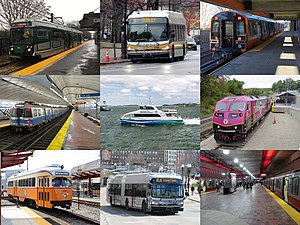 | |
| Overview | |
| Locale | Greater Boston, Massachusetts, US |
| Transit type | |
| Daily ridership | 731,200 (weekdays, Q1 2024)[1] |
| Annual ridership | 239,981,700 (2023)[2] |
| Chief executive | Phillip Eng |
| Headquarters | 10 Park Plaza Boston, Massachusetts 02116 |
| Website | mbta |
| Operation | |
| Began operation | August 1964 (Predecessors date back to 1834) |
| Operator(s) |
|
The Massachusetts Bay Transportation Authority (abbreviated MBTA and known colloquially as "the T")[3][4] is the public agency responsible for operating most public transportation services in Greater Boston, Massachusetts. The MBTA transit network includes the MBTA subway with three metro lines (the Blue, Orange, and Red lines), two light rail lines (the Green and Ashmont–Mattapan lines), and a five-line bus rapid transit system (the Silver Line); MBTA bus local and express service; the twelve-line MBTA Commuter Rail system, and several ferry routes. In 2023, the system had a ridership of 239,981,700, or about 731,200 per weekday as of the first quarter of 2024, of which the rapid transit lines averaged 255,800 and the light rail lines 63,600, making it the fourth-busiest rapid transit system and the third-busiest light rail system in the United States. As of the first quarter of 2024, average weekday ridership of the commuter rail system was 100,400, making it the fifth-busiest commuter rail system in the U.S.
The MBTA is the successor of several previous public and private operators. Privately operated transit in Boston began with commuter rail in 1834 and horsecar lines in 1856. The various horsecar companies were consolidated under the West End Street Railway in the 1880s and electrified over the next decade. The Boston Elevated Railway (BERy) succeeded the West End in 1897; over the next several decades, the BERy built a partially-publicly owned rapid transit system, beginning with the Tremont Street subway in 1897. The BERy came under the control of public trustees in 1919, and was subsumed into the fully-publicly owned Metropolitan Transit Authority (MTA) in 1947. The MTA was in turn succeeded in 1964 by the MBTA, with an expanded funding district to fund declining suburban commuter rail service. In its first two decades, the MBTA took over the commuter rail system from the private operators and continued expansion of the rapid transit system. Originally established as an individual department within the Commonwealth of Massachusetts, the MBTA became a division of the Massachusetts Department of Transportation (MassDOT) in 2009.
History
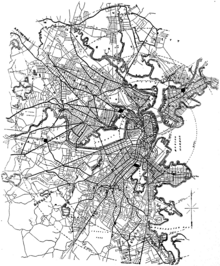
Mass transportation in Boston was provided by private companies, often granted charters by the state legislature for limited monopolies, with powers of eminent domain to establish a right-of-way, until the creation of the MTA in 1947. Development of mass transportation both followed and shaped economic and population patterns.[5]
Railways
Shortly after the steam locomotive became practical for mass transportation,[6] the private Boston and Lowell Railroad was chartered in 1830.[7] The rail, which opened in 1835,[6] connected Boston to Lowell,[8] a major northerly mill town in northeast Massachusetts' Merrimack Valley,[9] via one of the oldest railroads in North America. This marked the beginning of the development of American intercity railroads,[6] which in Massachusetts would later become the MBTA Commuter Rail system and the Green Line D branch.[10]
Streetcars
Starting with the opening of the Cambridge Railroad on March 26, 1856, a profusion of streetcar lines appeared in Boston under chartered companies.[11] Despite the change of companies, Boston is the city with the oldest continuously working streetcar system in the world. Many of these companies consolidated, and animal-drawn vehicles were converted to electric propulsion.[11]
Subways and elevated railways

Streetcar congestion in downtown Boston led to the subways in 1897 and elevated rail in 1901. The Tremont Street subway was the first rapid transit tunnel in the United States. Grade-separation added capacity and avoided delays caused by cross streets.[12] The first elevated railway and the first rapid transit line in Boston were built three years before the first underground line of the New York City Subway, but 34 years after the first London Underground lines, and long after the first elevated railway in New York City; its Ninth Avenue El started operations on July 1, 1868, in Manhattan as an elevated cable car line.
Various extensions and branches were added at both ends, bypassing more surface tracks. As grade-separated lines were extended, street-running lines were cut back for faster downtown service. The last elevated heavy rail or "El" segments in Boston were at the extremities of the Orange Line: its northern end was relocated in 1975 from Everett to Malden, Massachusetts, and its southern end was relocated into the Southwest Corridor in 1987. However, the Green Line's Causeway Street Elevated remained in service until 2004, when it was relocated into a tunnel with an incline to reconnect to the Lechmere Viaduct.[13] The Lechmere Viaduct and a short section of steel-framed elevated at its northern end remain in service, though the elevated section was cut back slightly and connected to a northwards viaduct extension as part of the Green Line Extension.[14]
Public enterprise

The old elevated railways proved to be an eyesore and required several sharp curves in Boston's twisty streets. The Atlantic Avenue Elevated was closed in 1938 amidst declining ridership and was demolished in 1942. As rail passenger service became increasingly unprofitable, largely due to rising automobile ownership, government takeover prevented abandonment and dismantlement. The MTA purchased and took over subway, elevated, streetcar, and bus operations from the Boston Elevated Railway in 1947.[15]
In the 1950s, the MTA ran new subway extensions, while the last two streetcar lines running into the Pleasant Street Portal of the Tremont Street Subway were substituted with buses in 1953 and 1962.[16] In 1958, the MTA purchased the Highland branch from the Boston and Albany Railroad, reopening it a year later as a rapid transit line (now the Green Line D branch).[17]
While the operations of the MTA were relatively stable by the early 1960s, the privately operated commuter rail lines were in freefall. The New Haven Railroad, New York Central Railroad, and Boston and Maine Railroad were all financially struggling; deferred maintenance was hurting the mainlines while most branch lines had been discontinued. The 1945 Coolidge Commission plan assumed that most of the commuter rail lines would be replaced by shorter rapid transit extensions, or simply feed into them at reduced service levels. Passenger service on the entire Old Colony Railroad system serving the southeastern part of the state was abandoned by the New Haven Railroad in 1959, triggering calls for state intervention. Between January 1963 and March 1964, the Mass Transportation Commission tested different fare and service levels on the B&M and New Haven systems. Determining that commuter rail operations were important but could not be financially self-sustaining, the MTC recommended an expansion of the MTA to commuter rail territory.[18]
On August 3, 1964, the MBTA succeeded the MTA, with an enlarged service area intended to fund continued commuter rail operations. The original 14-municipality MTA district was expanded to 78 cities and towns.[13] Several lines were briefly cut back while contracts with out-of-district towns were reached, but, except for the outer portions of the Central Mass branch (cut back from Hudson to South Sudbury), West Medway branch (cut back from West Medway to Millis), Blackstone Line (cut back from Blackstone to Franklin), and B&M New Hampshire services (cut back from Portsmouth to Newburyport), these cuts were temporary; however, service on three branch lines (all of them with only one round trip daily: one morning rush-hour trip in to Boston, and one evening rush-hour trip back out to the suburbs) was dropped permanently between 1965 and 1976 (the Millis (the new name of the truncated West Medway branch) and Dedham Branches were discontinued in 1967, while the Central Mass branch was abandoned in 1971). The MBTA bought the Penn Central (New York Central and New Haven) commuter rail lines in January 1973, Penn Central equipment in April 1976, and all B&M commuter assets in December 1976; these purchases served to make the system state-owned with the private railroads retained solely as operators.[13] Only two branch lines were abandoned after 1976: service on the Lexington branch (also with only one round trip daily) was discontinued in January 1977 after a snowstorm blocked the line, while the Lowell Line's full-service Woburn branch was eliminated in January 1981 due to poor track conditions.
The MBTA assigned colors to its four rapid transit lines in 1965, and lettered the branches of the Green Line from north to south. Shortages of streetcars, among other factors, caused bustitution of rail service on two branches of the Green Line. The A branch ceased operating entirely in 1969 and was replaced by the 57 bus,[13] while the E branch was truncated from Arborway to Heath Street in 1985, with the section between Heath Street and Arborway being replaced by the 39 bus.[13]
The MBTA purchased bus routes in the outer suburbs to the north and south from the Eastern Massachusetts Street Railway in 1968.[13] As with the commuter rail system, many of the outlying routes were dropped shortly before or after the takeover due to low ridership and high operating costs.
In the 1970s, the MBTA received a boost from the Boston Transportation Planning Review area-wide re-evaluation of the role of mass transit relative to highways. Producing a moratorium on highway construction inside Route 128, numerous mass transit lines were planned for expansion by the Voorhees-Skidmore, Owings and Merrill-ESL consulting team. The removal of elevated lines continued, and the closure of the Washington Street Elevated in 1987 brought the end of rapid transit service to the Roxbury neighborhood. Between 1971 and 1985, the Red Line was extended both north and south, providing not only additional subway system coverage, but also major parking structures at several of the terminal and intermediate stations.[13]
In 1981, seventeen people and one corporation were indicted for their roles in a number of kickback schemes at the MBTA.[19] Massachusetts Secretary of Transportation and MBTA Chairman Barry Locke was convicted of five counts of bribery and sentenced to 7 to 10 years in prison.[20][21]
21st century

By 1999, the district was expanded further to 175 cities and towns, adding most that were served by or adjacent to commuter rail lines, though the MBTA did not assume responsibility for local service in those communities adjacent to or served by commuter rail.[16][22] In 2016, the Town of Bourne voted to join the MBTA district, bringing the number of MBTA communities to 176.[23] Prior to July 1, 2000, the MBTA was reimbursed by the Commonwealth of Massachusetts for all costs above revenue collected (net cost of service). "Forward funding" introduced at that time consists of a dedicated revenue stream from assessments on served cities and towns, along with a 20% portion of the 5% state sales tax.[24]
The Commonwealth assigned to the MBTA responsibility for increasing public transit to compensate for increased automobile pollution from the Big Dig. However, these projects have strained the MBTA's limited resources, since the Big Dig project did not include funding for these improvements. Since 1988, the MBTA has been the fastest expanding transit system in the country, even as Greater Boston has been one of the slowest growing metropolitan areas in the United States.[25] The MBTA subsequently went into debt, and rates underwent an appreciable hike on January 1, 2007.[26]
In 2006, the creation of the MetroWest Regional Transit Authority saw several towns subtract their MWRTA assessment from their MBTA assessment, though the amount of funding the MBTA received remained the same. The next year, the MBTA started commuter rail service to the Greenbush section of Scituate, the third branch of the Old Colony service.[27] Rhode Island also paid for extensions of the Providence/Stoughton Line to T.F. Green Airport in 2010 and Wickford Junction in 2012. A new station on the Fairmount Line, the Talbot Avenue station, opened in November 2012.[28]
On June 26, 2009, Governor Deval Patrick signed a law to place the MBTA along with other state transportation agencies within the administrative authority of the Massachusetts Department of Transportation (MassDOT), with the MBTA now part of the Mass Transit division (MassTrans).[29][30][31][32] The 2009 transportation law continued the MBTA corporate structure and changed the MBTA board membership to the five Governor-appointed members of the Mass DOT Board.[33]

In February 2015, there was record breaking snowfall in Boston from the 2014–15 North American winter, which caused lengthy closures of portions of the MBTA subway system,[34] and many long-term operational and financial problems with the entire MBTA system coming under greater public attention,[35][36] Massachusetts Governor Charlie Baker subsequently announced the formation of a special advisory panel to diagnose the MBTA's problems and write a report recommending proposals to address them.[37] The special advisory panel formed the previous February released its report in April 2015.[38]
On March 19, 2015, using a grassroots tool, GovOnTheT, Steve Kropper, and Michele Rapp enlisted 65 Massachusetts General Court legislators to ride the T to the State House, pairing them with 85 TV, radio, electronic, and print reporters.[39] The event responded to widespread anger directed at the governor, state legislators, and MBTA management. The pairings helped to raise awareness of the problems with the T and contributed to its restructuring and refinancing.[40]
The next month, Baker appointed a new MassDOT Board of Directors and proposed a five-year winter resiliency plan with $83 million being spent to update infrastructure, purchase new equipment, and improve operations during severe weather.[41][42] A new state law established the MBTA Fiscal and Management Control Board, effective July 17, 2015,[43] with expanded powers to reform the agency during a five-year period. Its term was extended by another year in 2020.[44] Construction of the Green Line Extension, the first expansion to the rail rapid transit system since 1987, began in 2018.[45] In April 2018, the MBTA Silver Line began operating a route from Chelsea to South Station.[46]
A June 2019 Red Line derailment resulted in train delays for several months, which brought more attention to capital maintenance problems at the T. After complaints from many riders and business groups, the governor proposed adding $50 million for an independent team to speed up inspections and capital projects, and general efforts to speed up existing capital spending from $1 billion to $1.5 billion per year.[47] Replacement of the Red Line signal system was accelerated, including equipment that was damaged in the derailment. Baker proposed allocating to the MBTA $2.7 billion from the state's five-year transportation bond bill plus more money from the proposed multi-state Transportation and Climate Initiative.[48]
A December 2019 report by the MBTA's Fiscal and Management Control Board panel found "safety is not the priority at the T, but it must be." The report said, "there is a general feeling that fiscal controls over the years may have gone too far, which coupled with staff cutting has resulted in the inability to accomplish required maintenance and inspections, or has hampered work keeping legacy system assets fully functional."[49] In June 2021, the Fiscal and Management Control Board was dissolved,[50] and the following month, Baker signed into law a supplemental budget bill that included a provision creating a permanent MBTA Board of Directors, and Baker appointed the new board the following October.[51][52] In February 2022, MBTA staff reported to the MBTA Board of Directors safety subcommittee that of 61 recommendations made by the Fiscal and Management Control Board in 2019, two-thirds were complete and one-third were on progress or on hold (including all financial review recommendations).[53] In April 2022, the Federal Transit Administration announced in a letter to MBTA General Manager Steve Poftak that it would assume an increased safety oversight role over the MBTA and would conduct a safety management inspection.[54][55]
As of 2022, the MBTA had reduced its greenhouse gas emissions by 47% from 2009 levels, and now buys or produces 100% renewable electricity.[56]
Services
Subway
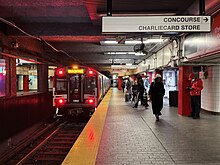
The subway system has three heavy rail rapid transit lines (the Red, Orange and Blue Lines), and two light rail lines (the Green Line and the Ashmont–Mattapan High-Speed Line, the latter designated an extension of the Red Line). The system operates according to a spoke-hub distribution paradigm, with the lines running radially between central Boston and its environs.[3] It is common usage in Boston to refer to all four of the color-coded rail lines which run underground as "the subway" or "the T", regardless of the actual railcar equipment used.[3]
All four subway lines cross downtown, forming a quadrilateral configuration, and the Orange and Green Lines (which run approximately parallel in that district) also connect directly at two stations just north of downtown. The Red Line and Blue Line are the only pair of subway lines which do not have a direct transfer connection to each other. Because the various subway lines do not consistently run in any given compass direction, it is customary to refer to line directions as "inbound" or "outbound". Inbound trains travel towards the four downtown transfer stations, and outbound trains travel away from these hub stations.[3]
The Green Line has four branches in the west: B (Boston College), C (Cleveland Circle), D (Riverside), and E (Heath Street). The A branch formerly went to Watertown, filling in the north-to-south letter assignment pattern, and the E branch formerly continued beyond Heath Street to Arborway.
The Red Line has two branches in the south, Ashmont and Braintree, named after their terminal stations.
The colors were assigned on August 26, 1965, in conjunction with design standards developed by Cambridge Seven Associates,[57] and have served as the primary identifier for the lines since the 1964 reorganization of the MTA into the MBTA. The Orange Line is so named because it used to run along Orange Street (now lower Washington Street), as the former "Orange Street" also was the street that joined the city to the mainland through Boston Neck in colonial times;[58] the Green Line because it runs adjacent to parts of the Emerald Necklace park system; the Blue Line because it runs under Boston Harbor; and the Red Line because its northernmost station was, at that time, at Harvard University, whose school color is crimson.[59]
Opened in September 1897, the four-track-wide segment of the Green Line tunnel between Park Street and Boylston stations was the first subway in the United States, and has been designated a National Historic Landmark. The downtown portions of what are now the Green, Orange, Blue, and Red line tunnels were all in service by 1912. Additions to the rapid transit network occurred in most decades of the 1900s, and continue in the 2000s with the addition of Silver Line bus rapid transit and planned Green Line expansion.[60] (See History and Future plans sections.)
Buses
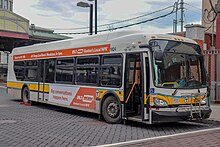
The MBTA bus system, the nation's sixth largest by ridership, has 152 bus routes. Most routes provide local service in the urban core; smaller local networks are also centered around Waltham, Lynn, and Quincy. The system also includes longer routes serving less-dense suburbs, including several express routes. The buses are colored yellow on maps and in station decor.[61] Most routes are directly operated by the MBTA, though several suburban routes are run by private operators under contract to the MBTA.
The Silver Line is also operated as part of the MBTA bus system. It is designated as bus rapid transit (BRT), even though it lacks some of the characteristics of bus rapid transit.[62][63][64] Two routes run on Washington Street between Nubian station and downtown Boston. Three "waterfront" routes run in a dedicated tunnel in South Boston and on the surface, elsewhere including the SL1 route that serves Logan Airport. Washington Street service, a belated replacement for the Washington Street Elevated, began in 2002 and was expanded in 2009. Waterfront service began in 2004, with an expansion to Chelsea opened in 2018.
MBTA predecessors formerly operated a large trolleybus network, much of which replaced surface streetcar lines.[65] Four lines based out of Harvard station lasted until 2022, when they were replaced with conventional buses. Three Silver Line routes operate as trolleybuses in the Waterfront Tunnel using dual-mode buses; these are scheduled to be replaced with hybrid battery buses in 2023.
Commuter rail
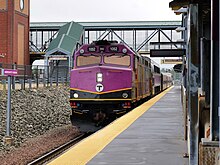
The MBTA Commuter Rail system is a commuter rail network that reaches from Boston into the suburbs of eastern Massachusetts. The system consists of twelve main lines, three of which have two branches. The rail network operates according to a spoke-hub distribution paradigm, with the lines running radially outward from the city of Boston, with a total of 394 miles (634 km) of revenue trackage.[66] Eight of the lines converge at South Station, with four of these passing through Back Bay station. The other four converge at North Station. There is no passenger connection between the two sides; the Grand Junction Railroad is used for non-revenue equipment moves accessing the maintenance facility. The North–South Rail Link has been proposed to connect the two halves of the system; it would be constructed under the Central Artery tunnel of the Big Dig.
Special MBTA trains are run over the Franklin/Foxboro Line and the Providence/Stoughton Line to Foxborough station for New England Patriots home games and other events at Gillette Stadium. The CapeFLYER intercity service, operated on summer weekends, uses MBTA equipment and operates over the Middleborough/Lakeville Line. Amtrak runs regularly scheduled intercity rail service over four lines: the Lake Shore Limited over the Framingham/Worcester Line, Acela Express and Northeast Regional services over the Providence/Stoughton Line, and the Downeaster over sections of the Lowell Line and Haverhill Line. Freight trains run by Pan Am Southern, Pan Am Railways, CSX Transportation, the Providence and Worcester Railroad, and the Fore River Railroad also use parts of the network.
The first commuter rail service in the United States was operated over what is now the Framingham/Worcester Line beginning in 1834. Within the next several decades, Boston was the center of a massive rail network, with eight trunk lines and dozens of branches. By 1900, ownership was consolidated under the Boston and Maine Railroad to the north, the New York Central Railroad to the west, and the New York, New Haven and Hartford Railroad to the south. Most branches and one trunk line – the former Old Colony Railroad main – had their passenger services discontinued during the middle of the 20th century. In 1964, the MBTA was formed to fund the failing suburban railroad operations, with an eye towards converting many to extensions of the existing rapid transit system. The first unified branding of the system was applied on October 8, 1974, with "MBTA Commuter Rail" naming and purple coloration analogous to the four subway lines.[13] The system continued to shrink – mostly with the loss of marginal lines with one daily round trip – until 1981. The system has been expanded since, with four lines restored (Fairmount Line in 1979, Old Colony Lines in 1997, and Greenbush Line in 2007), six extended, and a number of stations added and rebuilt, especially on the Fairmount Line.
Each commuter rail line has up to eleven fare zones, numbered 1A and 1 through 10. Riders are charged based on the number of zones they travel through. Tickets can be purchased on the train, from ticket counters or machines in some rail stations, or with a mobile app called mTicket.[67] If a local vendor or ticket machine is available, riders will pay a surcharge for paying with cash on board. Fares range from $2.40 to $13.25, with multi-ride and monthly passes available, and $10 unlimited weekend passes.[68] In 2016, the system averaged 122,600 daily riders, making it the fourth-busiest commuter rail system in the nation.[69]
Ferries
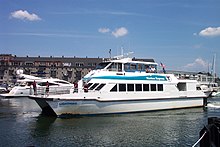
The MBTA boat system comprises several ferry routes via Boston Harbor. One of these is an inner harbor service, linking the downtown waterfront with the Boston Navy Yard in Charlestown. The other routes are commuter routes, linking downtown to Hingham, Hull, and Salem. Some commuter services operate via Logan International Airport.
All boat services are operated by private sector companies under contract to the MBTA. In FY2005, the MBTA boat system carried 4,650 passengers (0.41% of total MBTA passengers) per weekday.[70] The service is provided through contract of the MBTA by Boston Harbor Cruises (BHC).
Paratransit
The MBTA contracts out operation of "The Ride", a door to door service for people with disabilities. Paratransit services carry 5,400 passengers on a typical weekday, or 0.47% of the MBTA system ridership.[70][71] The two private service providers under contractual agreement with the MBTA for The Ride: Veterans Transportation LLC,[72] and National Express Transit (NEXT).
In September 2016, the MBTA announced that paratransit users would be able to get rides from Uber and Lyft. Riders would pay $2 for a pickup within a few minutes (more for longer trips worth more than $15) instead of $3.15 for a scheduled pickup the next day. The MBTA would pay $13 instead of $31 per ride ($46 per trip when fixed costs of The Ride are considered).[73]
Bicycles
Conventional bicycles are generally allowed on MBTA commuter rail, commuter boat, and rapid transit lines during off-peak hours and all day on weekends and holidays. However, bicycles are not allowed at any time on the Green Line, or the Ashmont–Mattapan High-Speed Line segment of the Red Line. Buses equipped with bike racks at the front (including the Silver Line) may always accommodate bicycles, up to the capacity limit of the racks. The MBTA claims that 95% of its buses are now equipped with bike racks, except for trackless trolleys which still lack this capability.[74]
Due to congestion and tight clearances, bicycles are banned from Park Street, Downtown Crossing, and Government Center stations at all times.[74]
However, compact folding bicycles are permitted on all MBTA vehicles at all times, provided that they are kept completely folded for the duration of the trip, including passage through faregates. Gasoline-powered vehicles, bike trailers, and Segways are prohibited.[74]
No special permit is required to take a bicycle onto an MBTA vehicle, but bicyclists are expected to follow the rules and hours of operation. Cyclists under 16 years old are supposed to be accompanied by a parent or legal guardian. Detailed rules, and an explanation of how to use front-of-bus bike racks and bike parking are on the MBTA website.[74]
The MBTA says that over 95% of its stations are equipped with bike racks, many of them under cover from the weather. In addition, over a dozen stations are equipped with "Pedal & Park" fully enclosed areas protected with video surveillance and controlled door access, for improved security. To obtain access, a personally registered CharlieCard must be used. Registration is done online, and requires a valid email address and the serial number of the CharlieCard. All bike parking is free of charge.[74]
Parking
As of 2014[update], the MBTA operates park and ride facilities at 103 locations with a total capacity of 55,000 automobiles, and is the owner of the largest number of off-street paid parking spaces in New England.[75] The number of spaces at stations with parking varies from a few dozen to over 2,500. The larger lots and garages are usually near a major highway exit, and most lots fill up during the morning rush hour. There are some 22,000 spaces on the southern portion of the commuter rail system, 9,400 on the northern portion and 14,600 at subway stations. The parking fee ranges from $4 to $7 per day, and overnight parking (maximum 7 days) is permitted at some stations.
Management for a number of parking lots owned by the MBTA is handled by a private contractor. The 2012 contract with LAZ Parking (which was not its first[76]) was terminated in 2017 after employees were discovered "skimming" revenue; the company paid $5.5 million to settle the case.[77] A new contract with stronger performance incentives and anti-fraud penalties was then awarded to Republic Parking System of Tennessee.[78]
Customers parking in MBTA-owned and operated lots with existing cash "honor boxes" can pay for parking online or via phone while in their cars or once they board a train, bus, or commuter boat.[79][80] As of February 2014[update], the MBTA switched from ParkMobile to PayByPhone as its provider for mobile parking payments by smartphone.[75] Monthly parking permits are available, offering a modest discount. Detailed parking information by station is available online, including prices, estimated vacancy rate, and number of accessible and bicycle parking slots.[75]
As of 2014[update], the MBTA has a policy for electric vehicle charging stations in its parking spaces, but does not yet have such facilities available.[81]
From time to time the MBTA has made various agreements with companies that contribute to commuting options. One company the MBTA selected was Zipcar; the MBTA provides Zipcar with a limited number of parking spaces at various subway stations throughout the system.[82]
Hours of operation
Traditionally, the MBTA has stopped running around 1 a.m. each day. Like many subways worldwide, the MBTA's subway does not have parallel express and local tracks, so much rail maintenance is only done when the trains are not running. An MBTA spokesperson has said, "with a 109-year-old system you have to be out there every night" to do necessary maintenance.[83] The MBTA did experiment with "Night Owl" substitute bus service from 2001 to 2005, but abandoned it because of insufficient ridership, citing a $7.53 per rider cost to keep the service open, five times the cost per passenger of an average bus route.[84]
A modified form of the MBTA's previous "Night Owl" service was experimentally reinstated starting in the spring of 2014 – this time, all subway lines were proposed to run until 3 am on weekends, along with the 15 most heavily used bus lines and the para-transit service "The Ride".[85][86]
Starting March 28, 2014, the late-night service began operation on a one-year trial basis, with service continuation depending on late-night ridership and on possible corporate sponsorship.[87] As of August 2014[update], late-night ridership was stable, and much higher than the earlier failed experimental service. However, it is still unclear whether and on what basis the program might be extended past its first year.[88] The extended hours program has not been implemented on the MBTA commuter rail operations.
In early 2016, the MBTA decided that Late-Night service would be canceled because of lack of funding. The last night for late-night service was on March 19, 2016. The last train left at 2 a.m. on March 19, 2016.
In 2018, the MBTA further tried "Early Morning and Late Night Bus Service Pilots[89]". In June 2019, a year after the trials the board voted to make some changes to the schedule which would allow for further late night service to be incorporated long term[90][91]
Ridership
| FY* | Ridership | ±% | ||
|---|---|---|---|---|
| 1964 | 386,700 | — | ||
| 1969 | 391,900 | +1.3% | ||
| 1970 | 385,693 | −1.6% | ||
| 1971 | 400,572 | +3.9% | ||
| 1973 | 359,681 | −10.2% | ||
| 1974 | 354,839 | −1.3% | ||
| 1975 | 341,086 | −3.9% | ||
| 1976 | 316,397 | −7.2% | ||
| 1977 | 345,255 | +9.1% | ||
| 1978 | 382,595 | +10.8% | ||
| 1979 | 387,353 | +1.2% | ||
| 1983 | 326,542 | −15.7% | ||
| 1984 | 338,192 | +3.6% | ||
| 1985 | 364,775 | +7.9% | ||
| 1986 | 378,817 | +3.8% | ||
| 1987 | 401,542 | +6.0% | ||
| 1988 | 378,166 | −5.8% | ||
| 1989 | 387,148 | +2.4% | ||
| 1990 | 416,887 | +7.7% | ||
| 1991 | 414,608 | −0.5% | ||
| 1992 | 412,366 | −0.5% | ||
| 1993 | 395,616 | −4.1% | ||
| 1995 | 404,298 | +2.2% | ||
| 1997 | 444,449 | +9.9% | ||
| 1999 | 590,942 | +33.0% | ||
| 2000 | 588,676 | −0.4% | ||
| 2001 | 659,500 | +12.0% | ||
| 2002 | 664,400 | +0.7% | ||
| 2003 | 656,400 | −1.2% | ||
| 2004 | 633,000 | −3.6% | ||
| 2005 | 617,300 | −2.5% | ||
| 2007 | 719,400 | +16.5% | ||
| 2008 | 733,637 | +2.0% | ||
| 2009 | 719,579 | −1.9% | ||
| 2010 | 719,933 | +0.0% | ||
| 2011 | 718,638 | −0.2% | ||
| 2012 | 752,700 | +4.7% | ||
| 2013 | 766,960 | +1.9% | ||
| 2014 | 788,400 | +2.8% | ||
| ||||
| Sources:[92][93] | ||||
During Fiscal Year 2013, the entire MBTA system had a typical weekday passenger ridership of 1,297,650. The MBTA's rapid transit lines (Red, Green, Orange, and Blue) accounted for 59% of all rides, buses accounted for 30%, and commuter rail accounted for 10% of all rides. The MBTA's ferries and paratransit accounted for the remaining 1% of rides.[94]
Passenger ridership has been steadily growing over the years, and between 2010 and 2013, the system saw passenger ridership grow 4.6% or an additional 57,000 daily passengers to the system.
| 2004 | 2007 | 2010 | 2013 | +/- | |
|---|---|---|---|---|---|
| Rapid transit | |||||
| Red Line | 210,500 | 226,417 | 241,603 | 272,684 | +29.5% |
| Green Line | 212,550 | 237,410 | 236,096 | 227,645 | +7.1% |
| Orange Line | 154,350 | 216,183 | 184,961 | 203,406 | +31.8% |
| Blue Line | 55,600 | 50,515 | 57,273 | 63,225 | +13.7% |
| Commuter rail | |||||
| MBTA Commuter Rail | 143,092 | 140,825 | 132,720 | 129,075 | −9.8% |
| Bus & trolley | |||||
| MBTA bus & trolley (includes Silver Line) |
382,600 | 355,588 | 374,040 | 387,815 | +1.4% |
| Silver Line | 14,100 | 25,715 | 30,026 | 29,839 | +111.6% |
| Ferry | |||||
| MBTA boat | 4,674 | 4,900 | 4,372 | 4,464 | −4.5% |
| Paratransit and contracted bus | |||||
| The Ride | 8,740 | 9,823 | 9,376 | 9,336 | +6.8% |
| Total | 1,172,106 | 1,241,631 | 1,240,441 | 1,327,489 | +10.7% |
